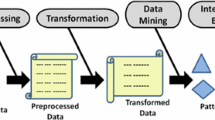Abstract
Most algorithms for mining sequential rules focus on generating all sequential rules. These algorithms produce an enormous number of redundant rules, making mining inefficient in intelligent systems. In order to solve this problem, the mining of non-redundant sequential rules was recently introduced. Most algorithms for mining such rules depend on patterns obtained from existing frequent sequence mining algorithms. Several steps are required to organize the data structure of these sequences before rules can be generated. This process requires a great deal of time and memory. The present study proposes a technique for mining non-redundant sequential rules directly from sequence databases. The proposed method uses a dynamic bit vector data structure and adopts a prefix tree in the mining process. In addition, some pruning techniques are used to remove unpromising candidates early in the mining process. Experimental results show the efficiency of the algorithm in terms of runtime and memory usage.







Similar content being viewed by others
References
Agrawal R, Srikant R (1995) Mining sequential patterns. In: IEEE international conference on data engineering, pp 3– 14
Ayres J, Gehrke J, Yiu T, Flannick J (2002) Sequential pattern mining using a bitmap representation. In: 8th ACM SIGKDD international conference on knowledge discovery and data mining, Edmonton, pp 429–435
Chiu DY, Wu YH, Chen ALP (2004) An efficient algorithm for mining frequent sequences by a new strategy without support counting. In: 20th International conference on data engineering, pp 375–386
Dong J, Han M (2007) BitTableFI: an efficient mining frequent itemsets algorithm. Knowl-Based Syst 20 (4):329–335
Fournier-Viger P, Gomariz A, Campos M, Thomas R (2014) Fast vertical mining of sequential patterns using co-occurrence information. In: Advances in knowledge discovery and data mining, LNAI, vol 8443, pp 40–52
Gomariz A, Campos M, Marin R, Goethals B (2013) ClaSP: an efficient algorithm for mining frequent closed sequences. In: Advances in knowledge discovery and data mining, LNAI, vol 7818, pp 50–61
Le B, Tran MT, Vo B (2015) Mining frequent closed inter-sequence patterns efficiently using dynamic bit vectors. Appl Intell 43:74–84
Lo D, Khoo SC, Wong L (2009) Non-redundant sequential rules theory and algorithm. Inf Syst 34 (4):438–453
Pei J, et al. (2001) PrefixSpan: mining sequential patterns efficiently by prefix-projected pattern growth. In: International conference. Data engineering, pp 215–224
Pham TT, Luo J, Hong TP, Vo B (2012) MSGPs: a novel algorithm for mining sequential generator patterns. In: Computational collective intelligence, technologies and applications, LNCS, vol 7654, pp 393–401
Pham TT, Luo J, Vo B (2013) An effective algorithm for mining closed sequential patterns and their minimal generators based on prefix trees. Int J Intell Inf Database Syst 7(4):324– 339
Pham TT, Luo J, Hong TP, Vo B (2014) An efficient method for mining non-redundant sequential rules using attributed prefix-trees. Eng Appl Artif Intell 32:88–99
Song S, Hu H, Jin S (2005) HVSM: a new sequential pattern mining algorithm using bitmap representation. Advanced Data Mining and Applications:455–463
Song W, Yang B, Xu Z (2008) Index-BitTableFI: an improved algorithm for mining frequent itemsets. Knowl-Based Syst 21(6):507–513
Spiliopoulou M (1999) Managing interesting rules in sequence mining. In: Principles of data mining and knowledge discovery, Springer Berlin Heidelberg, pp 554–560
Srikant R, Agrawal R (1996) Mining sequential patterns: Generalizations and performance improvements. In: Apers PMG, Bouzeghoub M, Gardarin G (eds) EDBT 1996, LNCS, vol 1057, pp 3–17
Tran MT, Le B, Vo B (2015) Combination of dynamic bit vectors and transaction information for mining frequent closed sequences efficiently. Eng Appl Artif Intell 38:183–189
Van TT, Vo B, Le B (2011) Mining sequential rules based on prefix-tree. In: New Challenges for Intelligent Information and Database Systems, Springer Berlin Heidelberg , pp 147–156
Van TT, Vo B, Le B (2014) IMSR_PreTree: an improved algorithm for mining sequential rules based on the prefix-tree. Vietnam J Comput Sci 1(2):97–105
Wang J, Han J, Li C (2007) Frequent closed sequence mining without candidate maintenance. IEEE Trans Knowl Data Eng 19(8):1042–1056
Yan X, Han J, Afshar R (2003) CloSpan: mining closed sequential patterns in large datasets. In: Proceedings of SIAM international conference on data mining, pp 166–177
Yang Z, Kitsuregawa M (2005) LAPIN-SPAM: an improved algorithm for mining sequential pattern. ICDE Workshops 2005:1222
Zaki M (2001) SPADE: an efficient algorithm for mining frequent sequences. Mach Learn 42(1–2):31–60
Acknowledgments
This work was funded by Vietnam’s National Foundation for Science and Technology Development (NAFOSTED) under grant number 102.05-2015.07.
Author information
Authors and Affiliations
Corresponding author
Rights and permissions
About this article
Cite this article
Tran, MT., Le, B., Vo, B. et al. Mining non-redundant sequential rules with dynamic bit vectors and pruning techniques. Appl Intell 45, 333–342 (2016). https://doi.org/10.1007/s10489-016-0765-3
Published:
Issue Date:
DOI: https://doi.org/10.1007/s10489-016-0765-3




